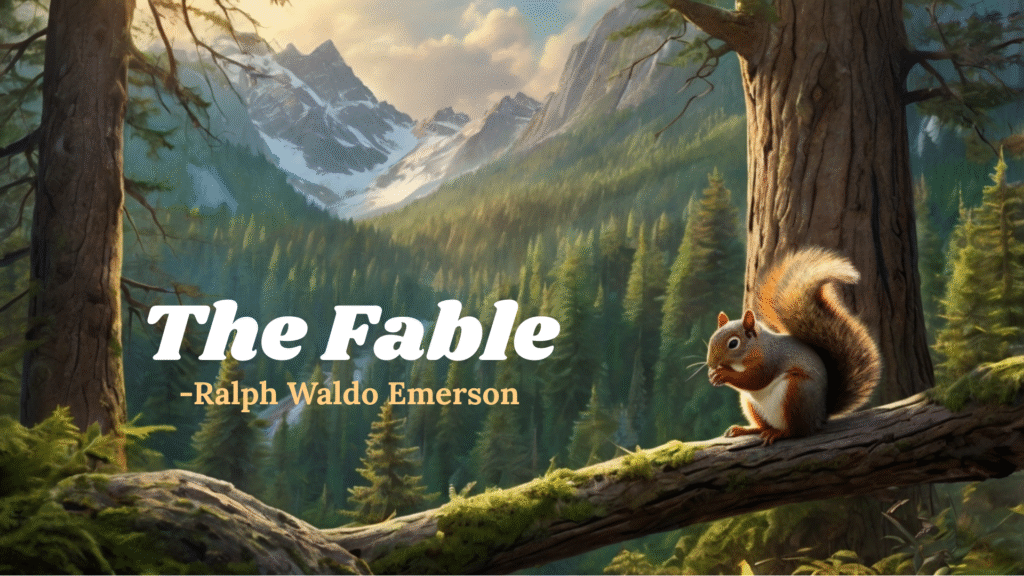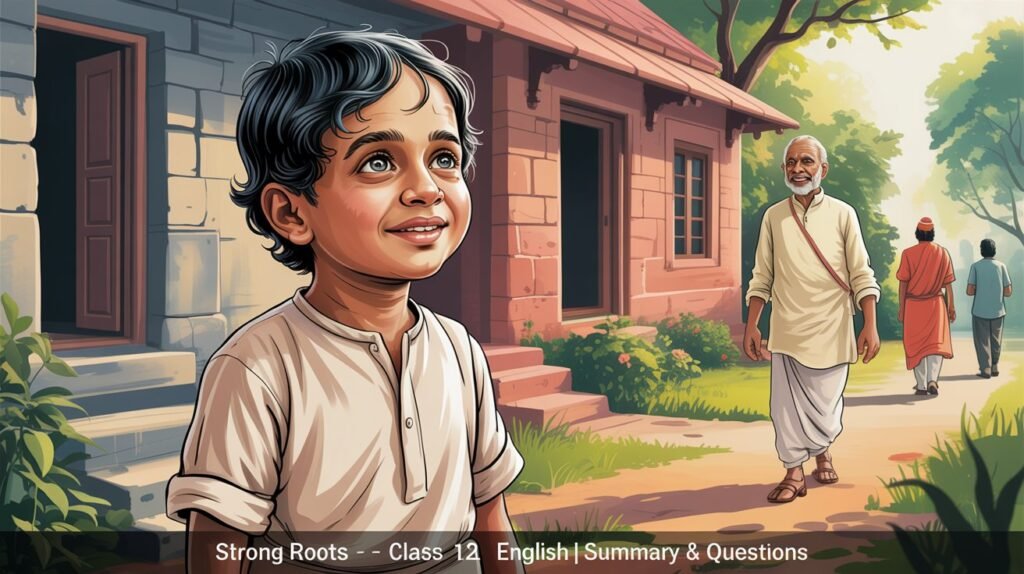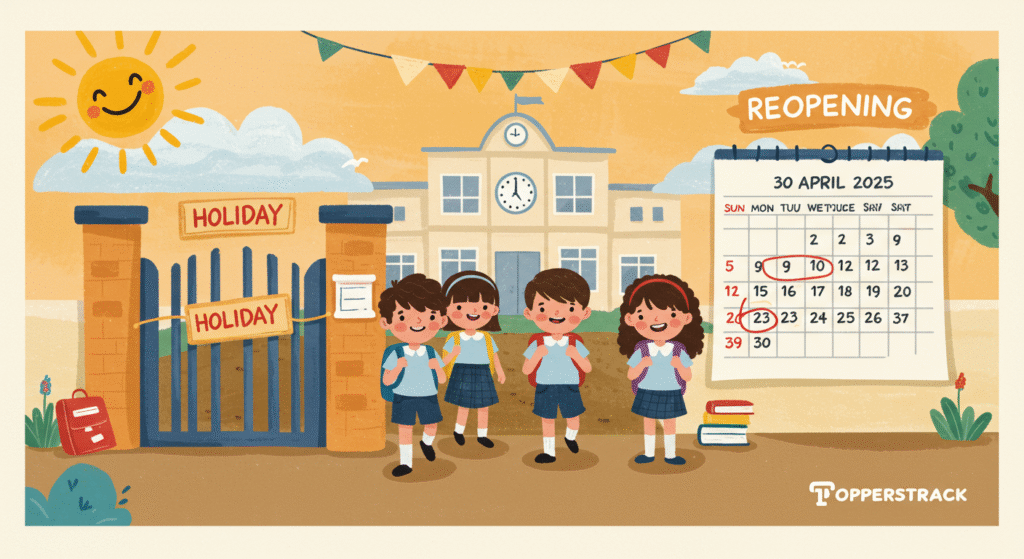
‘Fable’ by Ralph Waldo Emerson Summary, Question Answer: Class 10 English Syllabus
“Fable” কবিতাটি Ralph Waldo Emerson রচিত একটি ছোট অথচ তাৎপর্যপূর্ণ কবিতা, যা ক্লাস 10 ইংরেজি পাঠ্যসূচির গুরুত্বপূর্ণ অংশ। এই কবিতার মাধ্যমে শিক্ষার্থীরা শেখে যে প্রত্যেক জীব বা মানুষই নিজ নিজ অবস্থানে গুরুত্বপূর্ণ এবং প্রতিটি সত্তার নিজস্ব গুণ ও দায়িত্ব রয়েছে। কবিতাটি আত্মসম্মান, পারস্পরিক শ্রদ্ধা এবং বৈচিত্র্যের গুরুত্ব সম্পর্কে মূল্যবান বার্তা দেয়, যা ছাত্রছাত্রীদের মানসিক বিকাশে সহায়ক।
Fable
Ralph Waldo Emerson 1803 –1882
The mountain and the squirrel
Had a quarrel;
And the former called the latter ‘Little Prig.’
Bun replied,
‘You are doubtless very big;
But all sorts of things and weather
Must be taken in together,
To make up a year
And a sphere.
And I think it no disgrace
To occupy my place.
If I'm not so large as you,
You are not so small as I,
And not half so spry.
I'll not deny you make
A very pretty squirrel track;
Talents differ; all is well and wisely put;
If I cannot carry forests on my back,
Neither can you crack a nut.’
‘Fable’ by Ralph Waldo Emerson Summary: Class 10 English Syllabus
In the poem Fable, Ralph Waldo Emerson presents a conversation between a proud mountain and a clever squirrel. The mountain boasts about its size and strength, but the squirrel confidently replies that every creature has its own unique value. The poem teaches that all beings, big or small, have their own purpose and importance. Through humor and wisdom, it promotes equality, self-worth and the idea that "talents differ."
‘Fable’ by Ralph Waldo Emerson Summary in Bengali: Class 10 English Syllabus
রাল্ফ ওয়াল্ডো এমারসন-এর কবিতা "Fable"-এ এক গর্বিত পর্বত ও এক বুদ্ধিমান কাঠবিড়ালির কথোপকথনের মাধ্যমে একটি চিরন্তন সত্য তুলে ধরা হয়েছে। পর্বত তার বিশালতা ও শক্তির বড়াই করে আর কাঠবিড়ালি আত্মবিশ্বাসের সঙ্গে জানিয়ে দেয় যে—প্রত্যেক সৃষ্টিরই নিজস্ব গুণ ও মূল্য আছে। এই কবিতাটি কৌতুক ও প্রজ্ঞার সংমিশ্রণে আমাদের শেখায়, "প্রতিভা ভিন্ন ভিন্ন", আর এই ভিন্নতা দিয়েই তৈরি হয় ভারসাম্যপূর্ণ এক পৃথিবী। বড় হোক কিংবা ছোট—সবাই নিজের জায়গায় গুরুত্বপূর্ণ ও অর্থবহ। সমতা, আত্মসম্মান ও পরস্পরের মর্যাদার এই বাণী কবিতাটিকে করে তোলে অনন্য ও অনুপ্রেরণাদায়ক।
‘Fable’ by Ralph Waldo Emerson Question Answer: Class 10 English Syllabus
- Who is the author of the poem "Fable"?
(a) William Blake
(b) Ralph Waldo Emerson
(c) Robert Frost
(d) John Keats
Answer: (b) Ralph Waldo Emerson - What type of poem is "Fable"?
(a) Tragedy
(b) Ballad
(c) Narrative
(d) Allegorical/Didactic
Answer: (d) Allegorical/Didactic - What are the main characters in the poem?
(a) A lion and a rabbit
(b) A mountain and a squirrel
(c) A bear and a deer
(d) A man and a tree
Answer: (b) A mountain and a squirrel - What is the squirrel called in the poem?
(a) Bun
(b) Nibbles
(c) Rocky
(d) Tuffy
Answer: (a) Bun - What quality of the mountain does it boast of?
(a) Color
(b) Height and size
(c) Kindness
(d) Speed
Answer: (b) Height and size - What does the squirrel say about talents?
(a) All talents are equal
(b) Talents do not matter
(c) Talents differ
(d) Only big talents matter
Answer: (c) Talents differ - The poem uses a conversation between _____.
(a) Two birds
(b) A poet and the reader
(c) A mountain and a squirrel
(d) A tree and the wind
Answer: (c) A mountain and a squirrel - What does the squirrel carry?
(a) A seed
(b) A nut
(c) A leaf
(d) A flower
Answer: (b) A nut - Which of the following best describes the tone of the squirrel?
(a) Angry
(b) Humble
(c) Confident
(d) Fearful
Answer: (c) Confident - According to the poem, the mountain cannot:
(a) Run fast
(b) Crack a nut
(c) Speak
(d) Fly
Answer: (b) Crack a nut
‘Fable’ by Ralph Waldo Emerson Summary, Question Answer: Class 10 English Syllabus
- The squirrel values:
(a) Strength
(b) Wisdom
(c) Size
(d) Beauty
Answer: (b) Wisdom - The mountain is portrayed as:
(a) Humble
(b) Jealous
(c) Arrogant
(d) Funny
Answer: (c) Arrogant - The poet uses animals to:
(a) Entertain
(b) Explain a moral lesson
(c) Show nature’s beauty
(d) Make fun of people
Answer: (b) Explain a moral lesson - What does the squirrel climb?
(a) A rock
(b) A branch
(c) A tree
(d) A fir cone
Answer: (c) A tree - The squirrel says he is not as _____ as the mountain.
(a) Large
(b) Important
(c) Talented
(d) Smart
Answer: (a) Large - What does the squirrel imply about size?
(a) Bigger is better
(b) Size doesn't determine value
(c) Small things are useless
(d) He wants to be bigger
Answer: (b) Size doesn't determine value - What does the squirrel take pride in?
(a) Its tail
(b) Its ability to crack a nut
(c) Its voice
(d) Its running speed
Answer: (b) Its ability to crack a nut - What kind of rhyme does the poem use?
(a) No rhyme
(b) Rhyming couplets
(c) Free verse
(d) Blank verse
Answer: (b) Rhyming couplets - What does the squirrel suggest the mountain cannot do?
(a) Jump
(b) Crack a nut or climb a tree
(c) Fly in the sky
(d) Laugh out loud
Answer: (b) Crack a nut or climb a tree - What kind of poem is "Fable" in terms of content?
(a) Humorous and wise
(b) Sad and tragic
(c) Long and descriptive
(d) Dark and mysterious
Answer: (a) Humorous and wise - What lesson does the poem teach about abilities?
(a) They are all the same
(b) They do not matter
(c) Each ability is unique
(d) Only the strongest matters
Answer: (c) Each ability is unique - Why is the squirrel not afraid to speak to the mountain?
(a) It is proud
(b) It knows its worth
(c) It wants to escape
(d) It is angry
Answer: (b) It knows its worth - The squirrel mentions climbing:
(a) Trees and rocks
(b) Hills and dales
(c) Trees and the forest
(d) Trees and the bark
Answer: (b) Hills and dales
‘Fable’ by Ralph Waldo Emerson Summary, Question Answer: Class 10 English Syllabus
- The mountain's pride lies in its:
(a) Beauty
(b) Size and bulk
(c) Kindness
(d) Power over animals
Answer: (b) Size and bulk - The poem ends with a message about:
(a) Nature
(b) Power
(c) Equality and diversity
(d) Anger and revenge
Answer: (c) Equality and diversity - The squirrel believes that the mountain and it:
(a) Have nothing in common
(b) Are enemies
(c) Are both important in different ways
(d) Should fight
Answer: (c) Are both important in different ways - "Talents differ" means:
(a) No one has talent
(b) Everyone is the same
(c) Everyone has different strengths
(d) Only a few are talented
Answer: (c) Everyone has different strengths - What quality does the squirrel display in the poem?
(a) Laziness
(b) Confidence
(c) Arrogance
(d) Fear
Answer: (b) Confidence - Who has the ability to make a squirrel-track?
(a) The squirrel
(b) The wind
(c) The mountain
(d) The poet
Answer: (a) The squirrel - The poem "Fable" is written in:
(a) Old English
(b) Modern English
(c) Simple conversational English
(d) French
Answer: (c) Simple conversational English - What is the squirrel's view about comparison?
(a) Unnecessary
(b) Useful
(c) Always accurate
(d) A way to prove power
Answer: (a) Unnecessary - The squirrel says the mountain cannot compare with him in:
(a) Running
(b) Climbing
(c) Cracking nuts
(d) All of the above
Answer: (d) All of the above - According to the poem, what cannot be judged by size alone?
(a) Color
(b) Worth
(c) Age
(d) Shape
Answer: (b) Worth
‘Fable’ by Ralph Waldo Emerson Summary, Question Answer: Class 10 English Syllabus
- What is one of the squirrel’s daily tasks?
(a) Gathering food
(b) Singing
(c) Writing
(d) Sleeping
Answer: (a) Gathering food - What does the mountain symbolize in the poem?
(a) Intelligence
(b) Power and pride
(c) Weakness
(d) Joy
Answer: (b) Power and pride - What does the squirrel symbolize?
(a) Fear
(b) Bravery
(c) Humility and cleverness
(d) Laziness
Answer: (c) Humility and cleverness - Which literary device is central to the poem?
(a) Simile
(b) Allegory
(c) Irony
(d) Alliteration
Answer: (b) Allegory - The squirrel proves that intelligence can:
(a) Beat nature
(b) Be ignored
(c) Match size
(d) Triumph over brute strength
Answer: (d) Triumph over brute strength - The phrase “talents differ” promotes:
(a) Superiority
(b) Equality and uniqueness
(c) Anger
(d) Sadness
Answer: (b) Equality and uniqueness - What is the squirrel’s tone when replying to the mountain?
(a) Submissive
(b) Nervous
(c) Assertive
(d) Sad
Answer: (c) Assertive - “If I cannot carry forests on my back” implies:
(a) The squirrel is weak
(b) The squirrel is humble
(c) The squirrel knows his limits
(d) All of the above
Answer: (d) All of the above - The squirrel values:
(a) Beauty
(b) Grace
(c) His small skills
(d) Silence
Answer: (c) His small skills - The line “You are not so small as I” shows:
(a) Irony
(b) Mockery
(c) Comparison
(d) All of the above
Answer: (d) All of the above - What does the poem encourage readers to do?
(a) Be big
(b) Be quiet
(c) Respect all beings
(d) Fight for space
Answer: (c) Respect all beings
‘Fable’ by Ralph Waldo Emerson Summary, Question Answer: Class 10 English Syllabus
- What is the poem’s message for students?
(a) Compete with others
(b) Compare talents
(c) Believe in your own worth
(d) Don’t talk back
Answer: (c) Believe in your own worth - Who delivers the main message of the poem?
(a) The poet
(b) The mountain
(c) The squirrel
(d) The reader
Answer: (c) The squirrel - The poem is a good example of:
(a) A story with a lesson
(b) A sad tale
(c) A nature poem
(d) An angry speech
Answer: (a) A story with a lesson - The poem can best be described as:
(a) Satirical
(b) Inspirational
(c) Political
(d) Tragic
Answer: (b) Inspirational - “If I’m not so large as you...” is an example of:
(a) Rhetorical question
(b) Irony
(c) Humility and wit
(d) Conflict
Answer: (c) Humility and wit - The mountain’s voice represents:
(a) Humility
(b) Nature
(c) Ego and pride
(d) Silence
Answer: (c) Ego and pride
✍️ Fill in the Blanks – “Fable”
- The poem “Fable” is written by __________.
Answer: Ralph Waldo Emerson - The main animal character in the poem is a __________.
Answer: squirrel - The name of the squirrel in the poem is __________.
Answer: Bun - The squirrel talks to a __________.
Answer: mountain - The mountain boasts about its __________.
Answer: size
‘Fable’ by Ralph Waldo Emerson Summary, Question Answer: Class 10 English Syllabus
- The squirrel says that __________ differ.
Answer: talents - The squirrel defends his __________.
Answer: worth - The squirrel says he cannot carry __________ on his back.
Answer: forests - The squirrel says the mountain cannot crack a __________.
Answer: nut - The poem teaches us to respect all __________.
Answer: beings - The poem “Fable” is a type of __________ poem.
Answer: didactic - The squirrel is small but very __________.
Answer: clever - The mountain is large but not very __________.
Answer: wise - The poem uses __________ to teach a moral.
Answer: animals - The squirrel says the mountain is not so __________ as he is.
Answer: small - Bun is able to climb __________ and dales.
Answer: hills - The mountain cannot make a __________-track.
Answer: squirrel - The mountain calls the squirrel a little __________.
Answer: prig - Bun shows that being small has its own __________.
Answer: value
‘Fable’ by Ralph Waldo Emerson Summary, Question Answer: Class 10 English Syllabus
- “If I’m not so large as you, You are not so __________ as I.”
Answer: small - The squirrel believes that every being has its own __________.
Answer: purpose - The mountain represents __________ and arrogance.
Answer: pride - The squirrel represents humility and __________.
Answer: wisdom - The poem is written in a __________ tone.
Answer: humorous - According to the poem, no one is too small to be __________.
Answer: important - The squirrel’s task is to crack __________.
Answer: nuts - The squirrel replies to the mountain with __________.
Answer: confidence - The mountain cannot compare with the squirrel in __________.
Answer: skills - The squirrel says the world is a great __________.
Answer: place - The squirrel values his __________ and agility.
Answer: cleverness - The poet uses a __________ structure in the poem.
Answer: conversational - Bun believes in __________ of talents.
Answer: diversity - “Fable” encourages us to believe in our own __________.
Answer: worth - The mountain speaks with a tone of __________.
Answer: arrogance - The squirrel speaks with a tone of __________.
Answer: assertiveness
‘Fable’ by Ralph Waldo Emerson Summary, Question Answer: Class 10 English Syllabus
- The squirrel mentions climbing a tree and cracking a __________.
Answer: nut - Bun tells the mountain not to __________ him.
Answer: scold - The squirrel’s name is mentioned in the __________ line.
Answer: second - “Fable” uses a __________ between a mountain and a squirrel.
Answer: conversation - “Talents differ” is a powerful __________ from the poem.
Answer: message - The mountain cannot run, jump, or __________ a nut.
Answer: crack - The poem shows that big things and small things are both __________.
Answer: necessary - The squirrel moves across branches with __________.
Answer: ease - The poem ends with a lesson about mutual __________.
Answer: respect - The squirrel is not ashamed of being __________.
Answer: small - The mountain cannot perform __________ tasks.
Answer: delicate
‘Fable’ by Ralph Waldo Emerson Summary, Question Answer: Class 10 English Syllabus
- The squirrel can do things the mountain can never __________.
Answer: do - The squirrel sees value in his own __________.
Answer: abilities - The mountain and the squirrel represent two kinds of __________.
Answer: strengths - The poem promotes the idea of __________ and acceptance.
Answer: equality
📘 Short Answer Questions – “Fable”
- Who wrote the poem “Fable”?
Answer: Ralph Waldo Emerson. - What kind of poem is “Fable”?
Answer: It is a didactic poem that teaches a moral lesson. - Who are the two main characters in the poem?
Answer: A mountain and a squirrel. - What is the name of the squirrel in the poem?
Answer: - What does the mountain boast about?
Answer: Its size, strength, and ability to carry forests.
‘Fable’ by Ralph Waldo Emerson Summary, Question Answer: Class 10 English Syllabus
- How does the squirrel respond to the mountain’s boast?
Answer: By confidently stating that talents differ and every creature has value. - What message does the poem convey?
Answer: All beings, big or small, have their own unique importance. - What does “Talents differ” mean in the poem?
Answer: Everyone has different abilities, and all are important in their own way. - Why does the mountain insult the squirrel?
Answer: Because it believes the squirrel is small and unimportant. - What does the squirrel say about cracking a nut?
Answer: That the mountain cannot crack a nut, but the squirrel can. - Why is the squirrel not afraid of the mountain?
Answer: Because it knows its own worth and abilities. - What literary device is used by making animals talk in the poem?
Answer: - What kind of tone does the squirrel use?
Answer: Confident and witty. - What kind of tone does the mountain use?
Answer: Proud and arrogant.
‘Fable’ by Ralph Waldo Emerson Summary, Question Answer: Class 10 English Syllabus
- What kind of rhyme scheme is used in the poem?
Answer: Rhyming couplets. - How does the squirrel prove its worth?
Answer: By pointing out its unique abilities like climbing and cracking nuts. - Why can’t the mountain do what the squirrel can?
Answer: Because the mountain is too large and not agile. - What moral does the poem teach young readers?
Answer: Respect everyone’s talents and never underestimate small beings. - What does the mountain symbolize?
Answer: Pride, power, and physical strength. - What does the squirrel symbolize?
Answer: Humility, cleverness, and confidence. - What does the squirrel mean by “squirrel-track”?
Answer: A small path or movement that only a squirrel can make. - Is the squirrel ashamed of being small? Why/why not?
Answer: No, because it values its own talents. - What is a fable?
Answer: A short story with animals that teaches a moral lesson. - Why is this poem called a “fable”?
Answer: Because it uses animals to convey a moral teaching. - How does the squirrel describe its contribution to the world?
Answer: As important and necessary, though small. - What does the poem say about comparing others?
Answer: That comparison is meaningless because everyone is unique.
‘Fable’ by Ralph Waldo Emerson Summary, Question Answer: Class 10 English Syllabus
- What does the poem tell us about equality?
Answer: All creatures are equally valuable in their own way. - What kind of tasks is the squirrel good at?
Answer: Climbing, running, and cracking nuts. - What does the poem tell us about pride?
Answer: That pride based on size or power is not everything. - What lesson does the squirrel teach the mountain?
Answer: That even small beings have their own worth. - How does the squirrel justify his small size?
Answer: By showing that he can do things the mountain cannot. - What does the poem suggest about judging others?
Answer: We should not judge based on appearance or size. - How is the theme of diversity shown in the poem?
Answer: Through the line “talents differ” and the characters’ unique roles. - What is the main conflict in the poem?
Answer: Between physical size and mental ability. - What natural objects are used symbolically in the poem?
Answer: A mountain and a squirrel. - Why is the squirrel’s response important in the poem?
Answer: It delivers the poem’s central moral lesson. - What are the strengths of the mountain?
Answer: Its size and ability to carry forests. - What are the strengths of the squirrel?
Answer: Agility, intelligence, and usefulness. - How is humor used in the poem?
Answer: Through the witty and confident replies of the squirrel. - Why does the poem appeal to students?
Answer: Because it teaches self-worth and respect in a simple way. - How does the poem end?
Answer: With the message that all beings are important in their own way.
‘Fable’ by Ralph Waldo Emerson Summary, Question Answer: Class 10 English Syllabus
- What is the structure of the poem?
Answer: Short, rhymed lines in dialogue form. - Does the poem support arrogance or humility?
Answer: - How does the poet create contrast between the two characters?
Answer: Through their size and their attitudes. - Why is the poem still relevant today?
Answer: Because it promotes values of equality, respect, and diversity. - What makes the squirrel a strong character?
Answer: Its confidence and understanding of self-worth. - Why is the mountain limited despite its size?
Answer: Because it lacks agility and humility. - How does the poem encourage self-confidence?
Answer: By showing that everyone has something valuable to offer. - What lesson can we learn from Bun?
Answer: To believe in ourselves and not be discouraged by others' opinions. - What makes “Fable” a unique poem?
Answer: Its use of animal characters and simple language to teach deep moral lessons.
“Fable” কবিতাটি একটি সরল অথচ গভীর বার্তা বহন করে—জীবনে প্রতিটি মানুষ ও প্রাণীর আলাদা মূল্য ও গুরুত্ব রয়েছে। এখানে একটি বড় পাহাড় ও একটি ছোট কাঠবিড়ালির কথোপকথনের মাধ্যমে কবি দেখিয়েছেন যে শুধু আকার বা শক্তিতে বড় হলেই কেউ শ্রেষ্ঠ হয় না। প্রত্যেকেরই নিজস্ব প্রতিভা ও কাজের গুরুত্ব রয়েছে। এই কবিতা আমাদের আত্মসম্মান, পরস্পরের প্রতি শ্রদ্ধা ও বৈচিত্র্যকে মর্যাদা দেওয়ার শিক্ষা দেয়।
🔔 পরবর্তী আপডেট সম্পর্কে গুরুত্বপূর্ণ তথ্য:
এই প্রশ্নোত্তর তালিকায় ভবিষ্যতে যদি আরও নতুন প্রশ্ন যোগ করা হয়, তাহলে তোমরা এখানেই আপডেট পেয়ে যাবে। পাশাপাশি, আমাদের Topperstrack.in অ্যাপ-এর কোর্সে তোমরা পাবে –
✅ সাজেশন, উত্তরপত্র এবং রিভিশন সেট
✅ অধ্যায়ভিত্তিক স্টাডি রিসোর্স
✅ নিয়মিত মক টেস্ট ও কুইজ
🔔 পড়াশোনাকে আরও সহজ ও মজাদার করতে আমাদের সঙ্গেই থাকুন!
✅ এখনই যুক্ত হোন আমাদের 📚 Study Group-এ, যেখানে প্রতিদিন পাবেন গুরুত্বপূর্ণ নোটস, MCQ প্রশ্ন, সাজেশন এবং পরীক্ষা প্রস্তুতির টিপস!
👉 টেলিগ্রাম গ্রুপে যুক্ত হতে ক্লিক করুন:
📲 Join Telegram
👉 হোয়াটসঅ্যাপ চ্যানেলে যুক্ত হতে ক্লিক করুন:
📲 Join WhatsApp Channel
🎯 পড়াশোনা হোক আরও সহজ, গাইডলাইন থাক আমাদের সঙ্গেই!
👥 বন্ধুদের সাথেও শেয়ার করতে ভুলবেন না! 📖✨
💡 এছাড়াও আমাদের অফিসিয়াল ওয়েবসাইট 🌐 Topperstrack.in
এ গেলে তোমরা আরও অনেক বিষয়ভিত্তিক প্রস্তুতি ও শিক্ষনীয় সামগ্রী পাবে!
📱 তাই দেরি না করে এখনই Topperstrack.in অ্যাপ ডাউনলোড করো এবং Topperstrack.in -এ ভিজিট করে নিয়মিত প্র্যাকটিসে থাকো।



